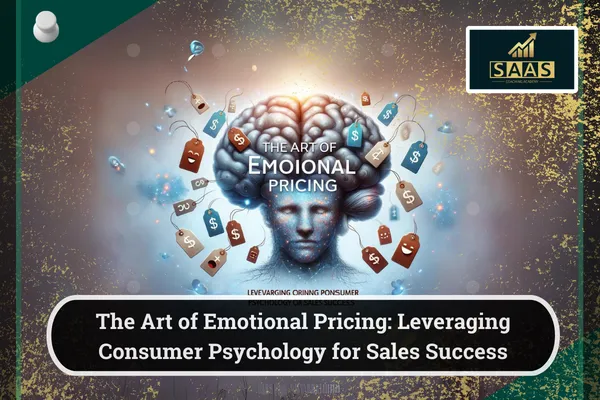Exciting Insights and Tips on Digital Marketing, Sales, Hustle Life, Customer Service, and Upcoming AI

The Art of Emotional Pricing: Leveraging Consumer Psychology for Sales Success
The Psychology of Pricing
Pricing is more than just setting a number; it's a strategic decision that can significantly impact consumer behavior. Understanding the psychology behind pricing is crucial for businesses looking to attract customers, drive sales, and ultimately maximize profitability. In this section, we will delve into the various psychological aspects of pricing and how they influence consumer decision-making.
One key concept we will explore is anchoring, which refers to the tendency for individuals to rely heavily on the first piece of information they receive when making decisions. This means that the initial price a customer sees can serve as an anchor point that influences their perception of value. By strategically setting anchor prices, businesses can shape how customers view the value of their products or services.
Price perception is another important factor that businesses need to consider. Customers often use price as a cue to infer the quality and value of a product. By understanding how customers perceive prices, businesses can adjust their pricing strategies to align with customer expectations and create a sense of value.
Moreover, pricing can have a significant impact on customer decision-making. The way prices are presented, such as using odd-even pricing or bundling products, can influence customers' perceptions and drive purchasing behavior. By leveraging pricing tactics that appeal to customers' psychological tendencies, businesses can create a sense of urgency and encourage customers to make a purchase.
By understanding the psychology of pricing, businesses can effectively set prices that resonate with their target audience and drive sales. In the following sections, we will further explore value-based pricing strategies, dynamic pricing techniques, pricing strategy for customer segmentation, and pricing optimization and testing. These sections will provide practical insights and examples to help businesses leverage pricing strategies to maximize sales and profitability. Stay tuned for valuable tips and strategies to enhance your pricing approach and achieve your business goals.

Value-Based Pricing Strategies
Building on our discussion of the psychology of pricing in Section 1, we now turn our attention to value-based pricing strategies. Understanding the value proposition of your products or services is essential for setting prices that resonate with your target audience and drive sales. By aligning your prices with the perceived value of your offerings, you can differentiate yourself from competitors, justify premium pricing, and ultimately increase profitability.
One key aspect of value-based pricing is effectively communicating the value of your products or services to customers. This involves highlighting the unique benefits and features that set your offerings apart from the competition and justify the price you are asking. By emphasizing the value that customers will receive in exchange for their money, you can create a sense of worth and desirability that encourages purchase.
Moreover, value-based pricing allows businesses to cater to different customer segments with varying needs and preferences. By offering tiered pricing options that align with the value each segment places on your offerings, you can maximize sales and customer satisfaction. For example, premium customers may be willing to pay more for additional features or services, while price-sensitive customers may be more interested in basic options at a lower price point.
In this section, we will provide practical examples of successful value-based pricing models and offer insights on how to implement them in your own business. By adopting a value-based pricing approach, you can create a pricing strategy that not only drives sales but also builds customer loyalty and enhances your brand reputation. Stay tuned for valuable tips on how to leverage value-based pricing strategies to maximize profitability and achieve your business goals.


Dynamic Pricing Techniques
Dynamic pricing is a strategy that allows businesses to adjust prices in real-time based on various factors such as demand, competition, and market conditions. By leveraging data and technology, businesses can optimize their pricing strategies to maximize revenue, improve competitiveness, and enhance customer segmentation.
One of the key benefits of dynamic pricing is the ability to respond quickly to changes in the market. By monitoring factors such as consumer behavior, competitor pricing, and inventory levels, businesses can adjust prices to reflect current demand and maximize profitability. This flexibility allows businesses to stay ahead of the competition and capture opportunities for increased sales.
Moreover, dynamic pricing enables businesses to better segment their customers and tailor prices to different segments. By analyzing customer data and purchasing patterns, businesses can identify price-sensitive customers, premium customers, and other segments with unique preferences. By offering personalized pricing options that cater to each segment, businesses can increase customer satisfaction and loyalty.
Implementing dynamic pricing techniques requires the use of advanced pricing tools and algorithms. These tools can analyze large amounts of data, predict demand trends, and recommend optimal pricing strategies. By leveraging these technologies, businesses can make data-driven pricing decisions that are more accurate and effective than traditional pricing methods.
Case studies have shown that companies across various industries have successfully implemented dynamic pricing strategies to boost sales and profitability. For example, airlines use dynamic pricing to adjust ticket prices based on factors such as seat availability and booking patterns. E-commerce retailers use dynamic pricing to offer personalized discounts and promotions to individual customers.
In conclusion, dynamic pricing techniques offer businesses a powerful tool to optimize their pricing strategies and drive revenue growth. By embracing data-driven pricing decisions and leveraging advanced technologies, businesses can stay competitive in today's dynamic market environment. Stay tuned for practical advice on how to implement dynamic pricing techniques in your business and achieve your pricing objectives.

Pricing Strategy for Customer Segmentation
Building on our discussion of the psychological aspects of pricing in Section 1, as well as the value-based pricing strategies in Section 2, we now turn our focus to the importance of customer segmentation in pricing strategy. Understanding the diverse needs and preferences of different customer segments is crucial for businesses looking to tailor their prices effectively and drive sales.
Customer segmentation involves dividing your customer base into distinct groups based on factors such as demographics, behavior, purchasing power, and preferences. By segmenting customers, businesses can gain valuable insights into what drives purchasing decisions for each group and how they perceive value. This enables businesses to develop pricing strategies that cater to the specific needs of each segment, ultimately leading to increased customer satisfaction and loyalty.
One key benefit of customer segmentation in pricing strategy is the ability to offer personalized pricing options to different customer segments. For example, premium customers who value additional features or services may be willing to pay a higher price, while price-sensitive customers may be more interested in discounts or promotions. By customizing prices to align with the perceived value of each segment, businesses can maximize sales and profitability.
Moreover, customer segmentation allows businesses to better understand their target audience and tailor their marketing efforts accordingly. By identifying the unique characteristics and preferences of each segment, businesses can create targeted marketing campaigns that resonate with customers and drive engagement. This personalized approach can help businesses build stronger relationships with customers and differentiate themselves from competitors.
In this section, we will provide practical tips on how to effectively segment customers and customize pricing strategies for each segment. We will discuss the benefits of customer segmentation in pricing strategy and offer examples of successful segmentation strategies. By leveraging customer segmentation in pricing, businesses can create a more personalized and targeted approach to pricing that drives sales and enhances customer loyalty. Stay tuned for valuable insights on how to implement customer segmentation in your pricing strategy and achieve your business goals.

Pricing Optimization and Testing
In this final section, we will delve into the concept of pricing optimization and testing, which plays a crucial role in maximizing sales and profitability for businesses. By continuously refining pricing strategies through testing and analysis, businesses can uncover valuable insights that inform future pricing decisions and drive revenue growth.
A key aspect of pricing optimization is A/B testing, where businesses compare the performance of different pricing strategies to determine which one is most effective. By testing variables such as pricing levels, discount offers, and promotional strategies, businesses can identify the optimal pricing approach that resonates with their target audience and drives sales.
Additionally, price elasticity analysis can help businesses understand how changes in price impact demand for their products or services. By analyzing price sensitivity among customers, businesses can adjust prices accordingly to maximize revenue and achieve a balance between sales volume and profitability.
Implementing pricing optimization and testing requires a data-driven approach and a willingness to experiment with different pricing strategies. By measuring the success of pricing initiatives and analyzing the results, businesses can make informed decisions that lead to improved pricing performance and increased competitiveness in the market.
In conclusion, pricing optimization and testing are essential components of a successful pricing strategy. By continuously refining pricing strategies based on data and insights, businesses can stay ahead of the competition, drive sales, and achieve their business goals. We encourage businesses to embrace pricing optimization and testing as a means to enhance their pricing approach and maximize profitability in today's dynamic market environment. Thank you for joining us on this journey through the psychology of pricing and value-based pricing strategies. We hope you have gained valuable insights and practical tips to leverage pricing strategies effectively in your business. Good luck on your pricing optimization journey!



© 2025 SaaS Coaching Academy | All Rights Reserved | All Sales Are Final No Refunds | Privacy Policy | Terms of Service | Contact Us
info@leadstoroi.com
541-270-3477

